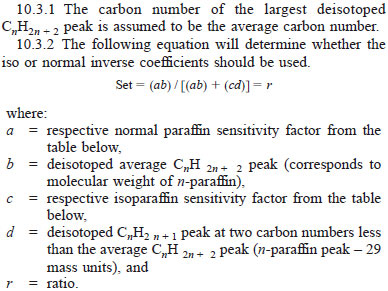ASTM D2786 Standard Test Method for Hydrocarbon Types Analysis of Gas-Oil Saturates Fractions by High Ionizing Voltage Mass Spectrometry
9. Procedure
9.1 If the mass spectrometer has been in continuous operation, no additional preparation is necessary before analyzing samples. However, if the spectrometer has been turned on only recently, check its operation according to the manufacturer's instructions to ensure stability before proceeding.
9.2 Obtain the mass spectrum of the sample, scanning from mass 67 to 409.
10. Calculation
10.1 Recording Mass Spectra - Read peak heights from the mass spectrum of the sample corresponding to the m/e+ itemized under 3.1.1.1 to 3.1.1.8, inclusive, and correct all peaks for heavy isotopes by the use of the two peaks immediately preceding the peak to be corrected.
10.2 Form the peak summations described under 3.1.1.1 to 3.1.1.8, inclusive.
10.3 Selection of Proper Inverse from Table 2:

NOTE 2 - Sample history and physical property data provide the best criteria for inverse selection and are preferred, if available, over the described procedure.

If r is 0.50 or higher, use the respective n-paraffin inverse coefficients; otherwise use the isoparaffin inverse coefficients. Interpolate where necessary.

NOTE 3 - The sensitivity factors in the above table are valid when the mass spectrometer is operated in such a mode as to give a 127/226 ratio for n-hexadecane of 1.4, approximately. If this ratio cannot be attained, an individual laboratory should replace the above factors with sensitivity data representative of actual instrument operation.
10.4 After the proper inverse has been selected, carry out the following calculations:

Repeat the corresponding calculation to obtain a solution for 1-ring, 2-ring, 3-ring, etc.
10.5 Normalize all partial ion intensities to 100.0 and report as volume percent.



